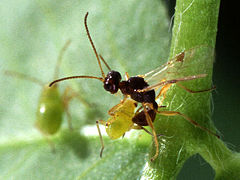
| Home | Sources Directory | News Releases | Calendar | Articles | | Contact | |
Parasitoid wasp
|
|
This article does not cite any references or sources. Please help improve this article by adding citations to reliable sources. Unsourced material may be challenged and removed. (August 2008) |
| Parasitoid wasp | |
|---|---|
 |
|
| Quarter-inch-long (6 mm) parasitoid wasp (Peristenus digoneutis, Ichneumonoidea: Braconidae) prepares to lay an egg in a tarnished plant bug nymph. | |
| Scientific classification | |
| Kingdom: | Animalia |
| Phylum: | Arthropoda |
| Class: | Insecta |
| Order: | Hymenoptera |
| Suborder: | Apocrita |
| Superfamilies | |
|
See text. |
|
The term parasitoid wasp refers to a large evolutionary grade of hymenopteran superfamilies, mainly in the Apocrita. They are primarily parasitoids of other animals, mostly other arthropods. Many of them, such as the family Braconidae, are considered beneficial to humans because they control populations of agricultural pests. Some of these wasps help pest control in a rather sophisticated manner. Certain types of plants have compounds that work in part with the saliva of caterpillars. When the saliva of the caterpillar and the juices of the plant mix, a fragrance is emitted that certain parasitoid wasps are very attracted to. The parasitoid wasps then kill the caterpillars and often use the carcasses to lay eggs within. This is a form of mutualism between the plant and the wasp and works only when the fragrance from the plant and the saliva combine.
Contents |
[edit] Taxonomy and systematics
Historically, the classification system of Hymenoptera included two divisions or infraorders within the suborder Apocrita: one of these, the "Parasitica" containing the parasitoid wasp. However, the use of the name Parasitica (or its alternative, "Terebrantia") has been phased out in recent years, as it is a paraphyletic grouping, and most modern classifications explicitly reject the use of any groups that are not monophyletic.
Presently, it is not clear what the eventual taxonomic fate of these groups will be. A number of clades seem to stand out in newer studies, and these may be treated as unranked taxa or at the ranks of infraorder and division.
[edit] Superfamilies
The traditional superfamilies united in the "Parasitica" are:
- Superfamily Ceraphronoidea
- Superfamily Chalcidoidea
- Superfamily Cynipoidea
- Superfamily Evanioidea
- Superfamily Ichneumonoidea
- Superfamily Megalyroidea
- Superfamily Mymarommatoidea (sometimes included in Serphitoidea)
- Superfamily Platygastroidea
- Superfamily Proctotrupoidea
- Superfamily Serphitoidea (fossil)
- Superfamily Stephanoidea
- Superfamily Trigonaloidea
Other than the "Parasitica", there are a few Apocrita that are also sometimes called "parasitic wasps": most of the members of the superfamily Chrysidoidea, as well as most of the families superfamily Vespoidea such as Bradynobaenidae, Mutillidae, Rhopalosomatidae, Sapygidae, Scoliidae, Sierolomorphidae, Tiphiidae, and a few species of Pompilidae. Most of these groups are ectoparasitoids. Among the sawflies, which are not Apocrita, there is only one small parasitic family, Orussidae. This is the Apocrita's closest living relative. It thus appears that the ancestors of bees and bumblebees were parasitic too.
[edit] Systematics
According to recent cladistic studies, there are a number of basal lineages among the Apocrita, as well as a diverse group of parasitic wasps that seems to form a major clade. If the Apocrita are divided into infraorders, about 6 of these must be recognized, and several of these warrant further subdivision, with a number of families being moved out of the Proctotrupoidea:

- Superfamily Ichneumonoidea seems closer to the Aculeata than to other parasitic wasps. If the Aculeata are treated as a division, the Ichneumonoidea would form a basal superfamily in a new infraorder.
- Superfamily Stephanoidea forms a clade or infraorder of its own.
- Another clade or infraorder contains the following groups:
- Superfamily Megalyroidea
- Superfamily Trigonaloidea
- a clade or division containing
- Superfamily Ceraphronoidea
- Superfamily Evanioidea.
- A clade or infraorder containing families formerly in the Proctotrupoidea:
- Family Maamingidae
- a clade, division or superfamily containing
- Family Austroniidae
- Family Diapriidae
- Family Monomachidae.
- Another clade or infraorder of families formerly in the Proctotrupoidea:
- Family Proctorenyxidae
- Family Roproniidae
- The bulk of the parasitic wasps, a clade or infraorder containing two very distinct groups:
- One clade or division containing:
- Superfamily Platygastroidea
- Superfamily Chalcidoidea
- Superfamily Mymarommatoidea (sometimes included in Serphitoidea)
- Superfamily Serphitoidea (fossil, tentatively placed here).
- Another clade or division containing:
- Superfamily Cynipoidea
- Superfamily Proctotrupoidea sensu stricto
- One clade or division containing:
[edit] External links
- Parasitic Wasp at Texas Cooperative Extension. Reprinted from Drees, Bastiaan M. and John A. Jackman. A Field Guide to Common Texas Insects. Houston: Gulf Publishing Company, 1999. ISBN 0877192634.
- Tree of Life Web Project: Apocrita
- Ponent Pictorial overview. (In Catalan)
- [1] Manipulation of host behaviour by a parasitoid
| This wasp-related article is a stub. You can help Wikipedia by expanding it. |
|
SOURCES.COM is an online portal and directory for journalists, news media, researchers and anyone seeking experts, spokespersons, and reliable information resources. Use SOURCES.COM to find experts, media contacts, news releases, background information, scientists, officials, speakers, newsmakers, spokespeople, talk show guests, story ideas, research studies, databases, universities, associations and NGOs, businesses, government spokespeople. Indexing and search applications by Ulli Diemer and Chris DeFreitas.
For information about being included in SOURCES as a expert or spokesperson see the FAQ . For partnerships, content and applications, and domain name opportunities contact us.